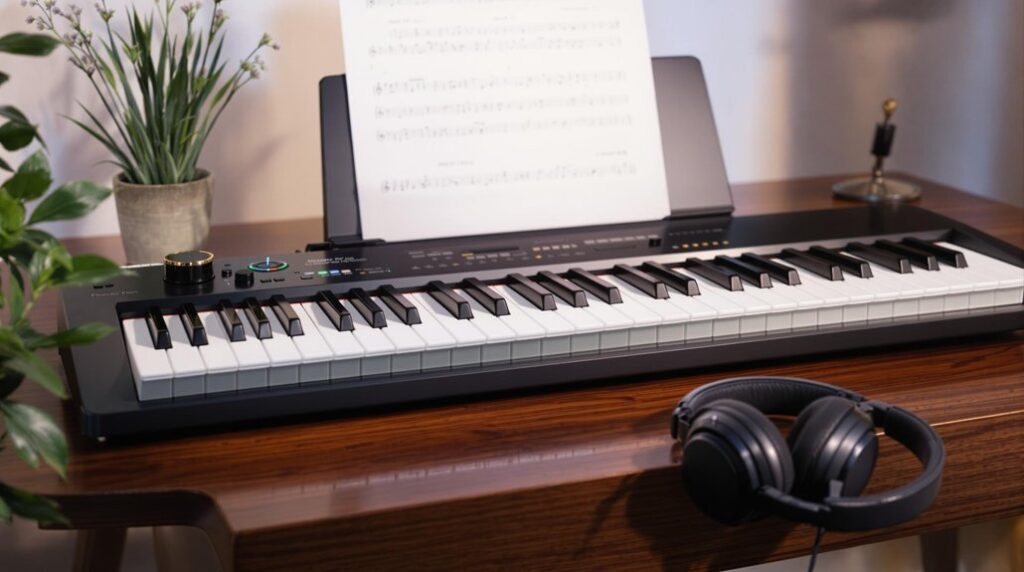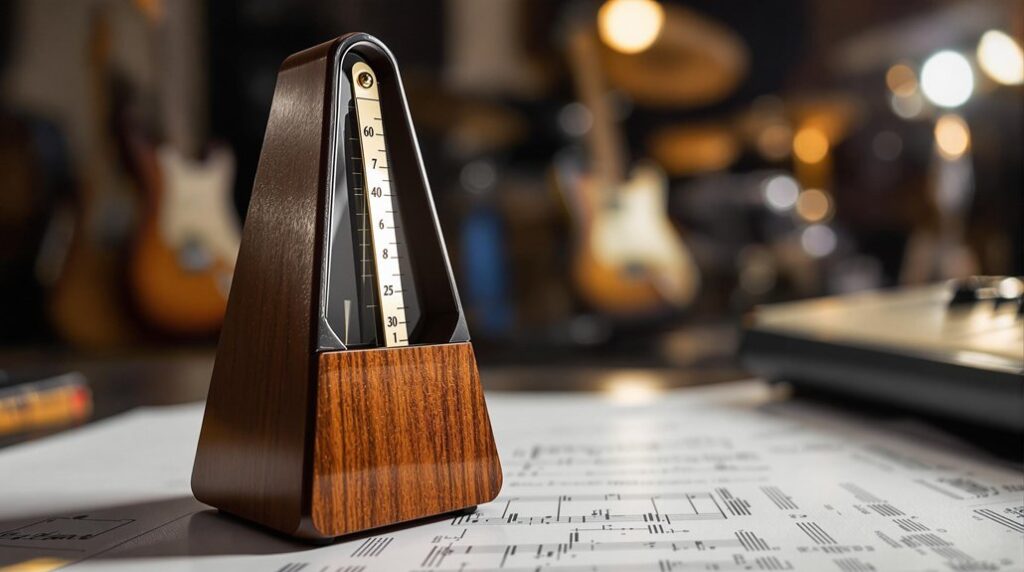To master music production scales, start by understanding the basics, like major and minor scales, and their emotional impacts. Explore different modes for unique sounds and variations. Practice essential chord progressions to establish strong foundations. Incorporate rhythm and timing to enhance melodic interest. Use scales for developing catchy melodies and harmonies, ensuring you experiment with various scales regularly. Don’t forget to apply these techniques in your production workflow for richer tracks. With these strategies, you’ll be well on your way to elevating your music production skills and discovering even deeper insights into your craft.
Key Takeaways
- Familiarize yourself with major and minor scales to understand their emotional impact on music production.
- Explore different modes, like Dorian and Phrygian, to enrich your harmonic vocabulary and add unique textures.
- Practice essential chord progressions (I-IV-V, ii-V-I) to strengthen your music production foundation.
- Experiment with rhythmic variations and time signatures to create engaging melodies and dynamic textures.
- Incorporate pentatonic and blues scales to enhance melodic interest and develop catchy hooks in your compositions.
Understand the Basics of Scales
Scales are the building blocks of music, and understanding them is essential for any producer. These collections of notes follow specific interval patterns that form the foundation for melodies and harmonies.
The major scale, with its bright and cheerful sound, contrasts with the minor scale, which brings a more somber tone. As you engage in learning scales, you’ll discover seven modes derived from the major scale, each offering unique emotional qualities. Understanding music modes can elevate your compositions and enhance emotional engagement.
Practicing these scales not only enhances your finger coordination and muscle memory but also improves your ability to create harmonically rich tracks. Familiarity with scale patterns and their relationship to chords reveals improvisational opportunities, making it crucial for your music theory concepts and overall production skills.
Explore Major and Minor Scales
While diving into music production, you’ll find that major and minor scales are essential to shaping the emotional terrain of your tracks. Understanding these scales can enhance your melodic and harmonic skills. Here are some key takeaways:
- Major Scales: Bright and happy, they follow a whole-whole-half-whole-whole-whole-half pattern, perfect for pop music.
- Minor Scales: Somber and melancholic, with a whole-half-whole-whole-half-whole-whole pattern, ideal for ballads and deep house.
- Natural Minor Scale: Shares notes with its relative major scale, starting on the sixth degree, making changes smoother.
- Melodic Minor Scale: Raises the sixth and seventh degrees when ascending, adding emotional depth and complexity to your compositions.
Mastering these elements is vital in creating effective chord progressions and melodies in your music production journey. Additionally, understanding the role of melody construction can further enrich your songwriting process.
Experiment With Modes
Understanding the unique characteristics of each mode can transform your composition process.
By incorporating modes into your music, you can explore a range of emotional effects, enhancing the depth and feel of your tracks.
Experimenting with these different tonalities not only broadens your harmonic vocabulary but also sparks innovation in your songwriting.
Understanding Mode Characteristics
Music production thrives on creativity, and experimenting with modes can greatly expand your sonic palette. Each mode, derived from major scales, has unique tonal characteristics that can evoke specific emotions.
Here are key modes to explore:
- Dorian: Offers a jazzy, bluesy feel, perfect for adding depth to your melody and harmony.
- Phrygian: Provides a darker, exotic sound, ideal for creating tension in electronic genres.
- Ionian: The major scale, it’s bright and uplifting, making it popular in pop and house music.
- Lydian: Creates a dreamy atmosphere with its raised fourth, often used in ambient tracks.
Utilizing these modes can enhance emotional depth and help you create movement in your compositions, leading to a unique sound.
Incorporating Modes in Composition
Experimenting with modes in your compositions can unfasten a wealth of creativity and emotional depth. Each mode offers unique characteristics; for instance, Dorian can bring a jazzy feel, while Phrygian evokes a dark, exotic sound.
Understanding these scales allows you to create distinct melodies and progressions that resonate with listeners. Incorporating modal interchange—switching between modes within the same piece—adds unexpected harmonic shifts, enhancing engagement.
For a dreamy ambiance, consider Lydian, and for tension, the dissonant Locrian mode works wonders in experimental music. By exploring these modes, you’ll enrich your music and evoke a range of emotions, leading to more compelling compositions that stand out in the current varied musical environment.
Exploring Emotional Effects
Exploring different modes can reveal a spectrum of emotional effects in your compositions. By understanding these scales, you can make informed choices that enhance the emotional depth of your tracks.
Here are four modes to reflect on:
- Dorian: Adds hopefulness through its raised sixth, perfect for complex melodies.
- Phrygian: Creates a darker atmosphere, ideal for evoking tension in your harmony.
- Lydian: Infuses a dreamy quality, making it great for ambient music.
- Locrian: Introduces dissonance, suitable for experimental soundscapes.
Each mode’s unique intervals shape your listener’s experience, allowing you to manipulate emotions effectively.
Immerse yourself in these modes and watch how they transform your music, deepening your understanding of melody and harmony.
Practice Chord Progressions
To enhance your music production skills, it’s vital to familiarize yourself with essential chord progression patterns like I-IV-V and ii-V-I. These progressions not only provide a foundation for your tracks but also evoke different emotional responses, adding depth to your compositions. Experimenting with unique chord voicings can further enrich your sound and help distinguish your music from others.
Essential Progression Patterns
While mastering essential chord progressions is crucial for any aspiring music producer, understanding how they evoke emotions can enhance your compositions considerably.
Familiarizing yourself with common chord progressions like I-IV-V and vi-IV-I-V is a great start. Here are some tips to help you practice:
- Shift smoothly between chords to maintain consistent rhythm and timing.
- Experiment with variations by introducing secondary dominants for unique harmonic textures.
- Utilize software tools or MIDI controllers to visualize and play different progressions.
- Regularly incorporate new chord progressions into your work to expand your creative palette.
Emotional Impact Exploration
Understanding how different chord progressions evoke specific emotional responses is a game-changer for music producers. Practicing common progressions like I-IV-V and ii-V-I helps you grasp their emotional impact.
For instance, using minor chords can create a somber mood, perfect for ballads or deep house tracks. On the other hand, major chords often convey happiness and brightness.
Experimenting with the Dorian mode adds a jazzy feel, enriching funk and progressive house music. Additionally, incorporating syncopation can make your chord progressions more dynamic and engaging.
Regularly revisiting these scales in various keys deepens your learning and enhances your production skills. By mastering these emotional aspects, you’ll create music that resonates with listeners profoundly.
Incorporate Rhythm and Timing
- Experiment with different time signatures, like 4/4 or 3/4, to achieve distinct sounds.
- Use syncopation to surprise listeners, placing accents on off-beats for added movement.
- Incorporate dynamic variations, such as ghost notes, to create complex rhythmic textures.
- Practice scales with rhythmic variations, ascending or descending, to deepen your understanding of how timing interacts with melodic elements.
- Understanding even-note syncopation can elevate your rhythmic creativity, allowing for more engaging musical phrases.
Embrace this learning process, and watch your productions come alive!
Use Scales for Melodic Development
As you immerse yourself in melodic development, using scales effectively can release a treasure trove of creative possibilities.
Start by exploring different major and minor scales; major scales create catchy, bright melodies, while minor scales offer a more somber tone.
Don’t overlook pentatonic scales, which consist of five notes and provide versatile, memorable melodies across genres like pop and hip-hop.
You can also incorporate modal scales, such as Dorian for a jazzy feel or Phrygian for a distinctive sound.
To enhance your melodies, use rhythmic variation and repetition, keeping listeners engaged.
Finally, leverage arpeggios derived from scales to enrich your ideas, creating smooth shifts between harmony and melody for effective melodic development. Additionally, consider dynamics control to ensure your melodies maintain expressive qualities throughout your production.
Apply Scales in Production Techniques
Applying scales in your production techniques can greatly enhance the emotional impact and creativity of your tracks. By understanding how to make the most of common scales, you can shape the sound and mood of your music.
Here are some key strategies:
- Use major scales for bright, uplifting melodies and minor scales for more somber emotions.
- Incorporate pentatonic and blues scales to create catchy hooks that resonate across genres.
- Experiment with modes, like Dorian or Phrygian, to introduce unique tonal qualities.
- Leverage scale patterns for improvisation, allowing for spontaneous creativity as notes are played.
- Understanding the emotional quality of different scales can further empower your creative choices in production.
Frequently Asked Questions
How Can I Memorize Music Scales Fast?
To memorize music scales fast, use scale visualization techniques and mnemonic devices. Prioritize practice frequency, engage in scale application exercises, enhance auditory recognition training, familiarize yourself with the keyboard layout, and explore creative improvisation practices.
What Is the Easiest Way to Learn Scales?
To learn scales easily, focus on scale patterns with visual aids like scale charts. Incorporate finger exercises, ear training, and practice routines. Experiment with chord progressions and improvisation techniques to enhance your understanding and enjoyment.
How to Understand Scales in Music for Beginners?
To understand scales in music, focus on scale theory, major and minor scales, and the chromatic scale. Engage in scale exercises, practice pentatonic patterns, and enhance your ear training for a richer musical experience.
How to Actually Get Better at Music Production?
To get better at music production, explore different genres, master mixing techniques, and optimize your workflow. Experiment with sound design and audio effects, and practice beat making while understanding mastering basics to enhance your tracks.
Conclusion
Mastering music production scales isn’t just about theory; it’s about applying what you learn in a practical way. By understanding the basics, exploring different scales and modes, and incorporating them into your compositions, you’ll raise your music to new heights. Don’t forget to practice your chord progressions and experiment with rhythm. The more you play around with scales in your production techniques, the more unique and compelling your sound will become. Keep experimenting and have fun!




